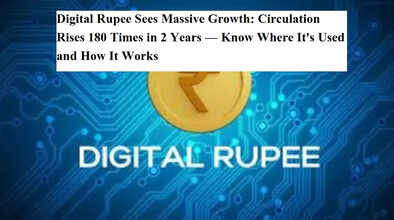Digital Rupee Sees Massive Growth: Circulation Rises 180 Times in 2 Years — Know Where It's Used and How It Works

New Delhi: The Reserve Bank of India's (RBI) digital rupee has witnessed exponential growth over the past two years. As per official RBI data, the retail value of digital rupee has surged from ₹5.7 crore in March 2023 to over ₹1,016 crore by March 2025 — a 180-fold increase.
What Is Digital Rupee?
The digital rupee is a central bank digital currency (CBDC) issued by the RBI. It is a tokenized version of the Indian rupee, existing in a digital format. Customers can use a designated app provided by banks to convert traditional INR into digital rupee and perform transactions using QR codes.
Is Interest Paid on Digital Rupee?
No, unlike bank deposits, the digital rupee does not earn interest.
When Was It Launched?
The RBI launched the digital rupee under a pilot project in late 2022. In just two years, the number of digital currency units has increased from 17.1 lakh to 4.94 crore, marking a 29-fold increase in volume. As of FY2025, ₹500 digital notes made up over 84% of the total value in circulation.
Who Can Use Digital Rupee?
The RBI has partnered with eight banks to run the pilot:
-
Phase 1: SBI, ICICI Bank, Yes Bank, IDFC First Bank
-
Phase 2: Union Bank of India, HDFC Bank, Bank of Baroda, Kotak Mahindra Bank
These banks provide an app through which eligible users can buy and use the digital rupee. Currently, this facility is available only in select cities: New Delhi, Mumbai, Bengaluru, and Bhubaneswar.
RBI's Vision Behind Digital Rupee
RBI aims to boost digital transactions, promote financial inclusion, and reduce dependency on cash. The digital rupee also enhances transaction transparency and minimizes the risk of fraud and money laundering, as every transaction can be tracked and recorded.
Is It a Cryptocurrency?
No, the digital rupee is not a cryptocurrency. It is a legal tender issued and regulated by the Reserve Bank of India. In contrast, cryptocurrencies are decentralized and not recognized as legal tender. Also, the issuer of most cryptocurrencies is unknown, unlike the RBI-backed digital rupee.
How Is It Different from Traditional Rupee?
| Aspect | Traditional Rupee | Digital Rupee |
|---|---|---|
| Form | Physical (cash/coins) | Digital/token-based |
| Issuer | RBI | RBI |
| Legal Tender | Yes | Yes |
| Interest Bearing | No | No |
| Use Cases | All physical transactions | Digital transactions via QR code |
| Traceability | Limited | Fully traceable |
Conclusion: With massive growth in usage and RBI’s ongoing efforts to expand its reach, the digital rupee is set to play a key role in India’s transition towards a cashless and digitally inclusive economy.

